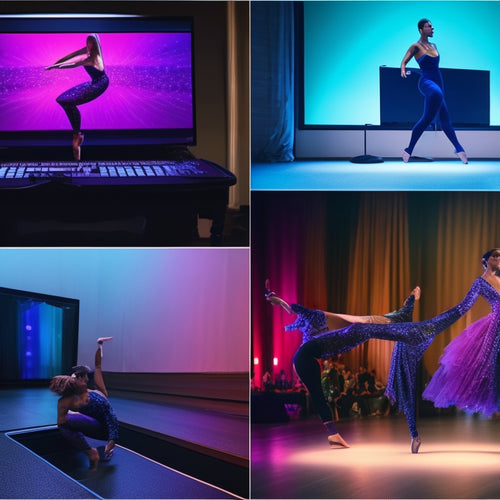
Revolutionizing Dance Progress Tracking: Engage and Inspire
Share
Accurate and timely tracking of progress is pivotal in revolutionizing dance education, as it empowers dancers to take ownership of their development, fosters a culture of continuous improvement, and sets achievable goals. By monitoring progress, dancers can identify areas for refinement, celebrate milestones, and refine techniques. A supportive community is also essential, where shared success stories and testimonials inspire motivation and confidence. To further explore the transformative power of progress tracking and its impact on dance instruction, let us examine the interconnected dynamics that drive growth and inspiration in the dance community.
Key Takeaways
• Accurate progress tracking empowers dancers to refine techniques, build confidence, and set achievable goals, inspiring motivation and a growth mindset.
• Sharing success stories within the dance community fosters camaraderie, celebrates individual achievements, and reinforces a sense of accomplishment.
• Progress tracking enables dancers to take ownership of their development, elevating the quality of instruction and promoting a culture of continuous improvement.
• By setting realistic targets and tracking progress, dancers can celebrate achievements, boosting confidence and morale, and driving autonomous motivation.
• Effective progress tracking revolutionizes dance instruction, providing clear goals and benchmarks, and inspiring dancers to strive for excellence.
Tracking Progress, Inspiring Growth
Accurate and timely tracking of progress is essential for dancers to refine their techniques, build confidence, and set achievable goals, ultimately inspiring growth and improvement in their craft.
By monitoring progress, dancers can identify areas for improvement, set realistic targets, and celebrate their achievements. This inspires motivation, as dancers witness their own development and recognize the fruits of their labor.
Celebrating achievements, no matter how small, reinforces positive behaviors and fosters a growth mindset. As dancers track their progress, they develop a sense of ownership and accountability, propelling them to aim for excellence.
Sharing Success, Fostering Community
By sharing their progress and achievements, dancers can foster a sense of community and camaraderie, as they bond over their collective growth and celebrate individual successes.
This collective celebration of achievements strengthens the bond between dancers, encouraging a supportive environment that promotes connections and motivates individuals to pursue excellence.
By sharing success stories and testimonials, dancers can inspire and motivate one another, creating a positive and uplifting atmosphere.
Celebrating achievements also reinforces the sense of accomplishment, further boosting confidence and morale.
As dancers share their progress, they create a network of support and encouragement, ultimately leading to a more cohesive and motivated dance community.
Empowering Dancers, Elevating Studios
Through dance progress tracking, studios can empower dancers to take ownership of their development, elevating the overall quality of instruction and fostering a culture of continuous improvement.
By providing dancers with clear goals and benchmarks, studios can promote autonomy and motivation. This, in turn, enables dancers to set realistic targets, track their progress, and celebrate their achievements.
As dancers take ownership of their development, studios can focus on elevating their instruction, refining their teaching methods, and providing targeted support.
Frequently Asked Questions
What Is the Ideal Frequency for Sharing Progress Updates With Parents?
'A fortnightly cadence of progress updates maintains parental engagement, fostering trust and consistency, while avoiding overwhelming information fatigue, hence ensuring a harmonious dance between parental involvement and dancer growth.'
How Often Should Dancers Set New Goals and Objectives?
Ideal goal setting frequency for dancers lies in striking a balance between regular objective reassessment and allowing sufficient time for skill mastery, suggesting a 4-6 week cycle for setting new goals and objectives, fostering focused progress and motivation.
Can Progress Sharing Be Adapted for Dancers With Disabilities?
Adapting progress sharing for dancers with disabilities requires inclusive strategies, such as accessible choreography and tailored feedback methods, ensuring equal opportunities for growth and development, while prioritizing safety and accessibility.
Are There Any Data Privacy Concerns With Online Progress Tracking?
As digital footprints multiply, a virtual labyrinth of data emerges, demanding vigilant protection. Ensuring data anonymity and shielding against cybersecurity threats is essential, lest online progress tracking becomes a Achilles' heel, compromising dancer privacy and trust.
What Is the Recommended Format for Sharing Video Feedback With Dancers?
For sharing video feedback with dancers, we suggest utilizing private links to guarantee secure access, accompanied by virtual showcases to facilitate constructive feedback and personalized coaching, while upholding confidentiality and data privacy.
Related Posts
-

Elevate Your Dance Choreography With Top Video Editing Tools
You're just a few clicks away from maximizing your dance choreography potential! With top video editing tools like Ad...
-

Must-Have Self Care Products for Mindful Living
To adopt mindful living, consider must-have self-care products like mindfulness journals and essential oils. Journals...
-

Instant Download Card for Dance Recital Performances
Instant download cards are a convenient way to commemorate dance recital performances, providing a seamless solution ...


